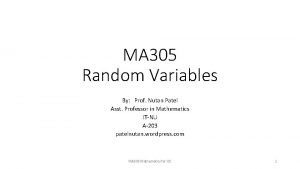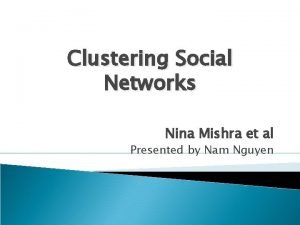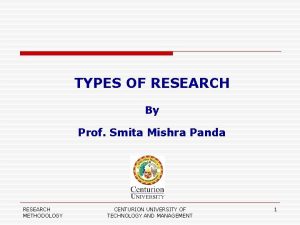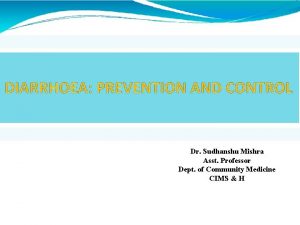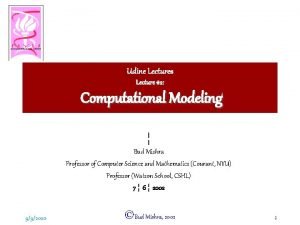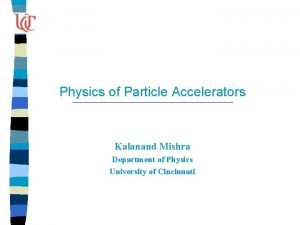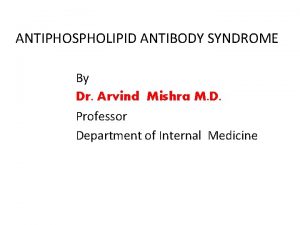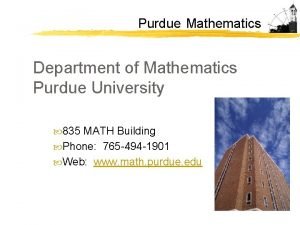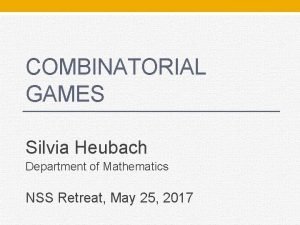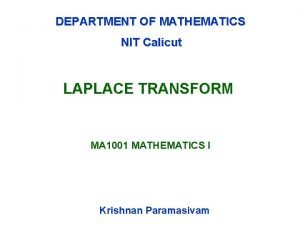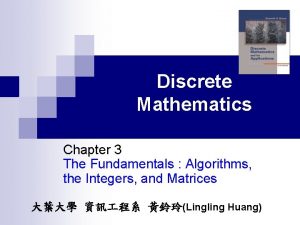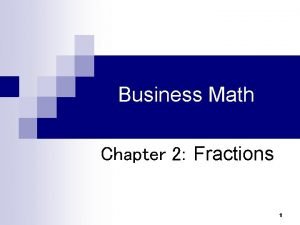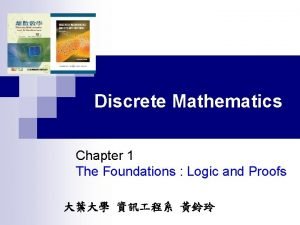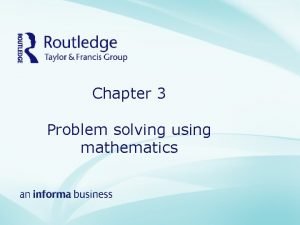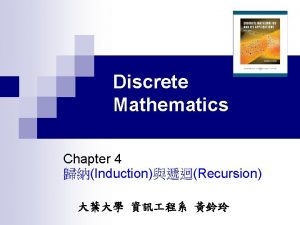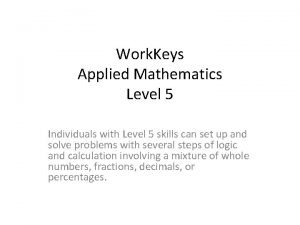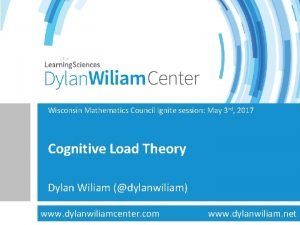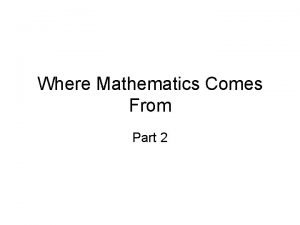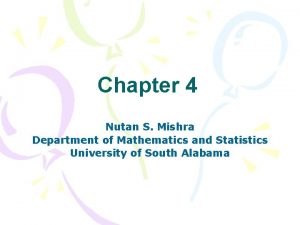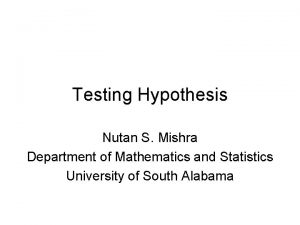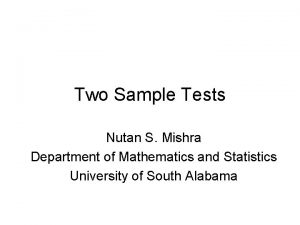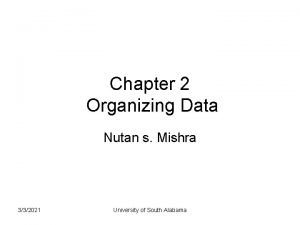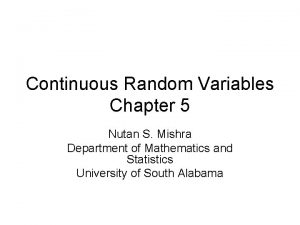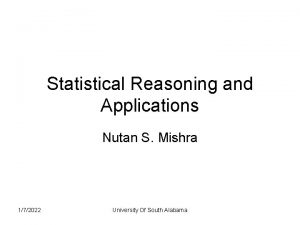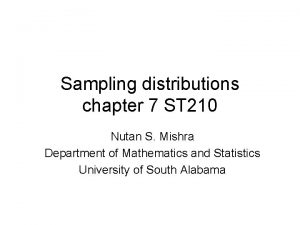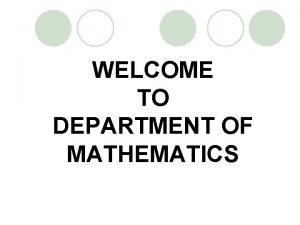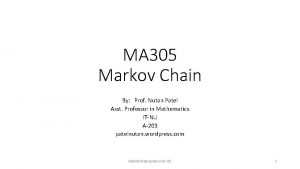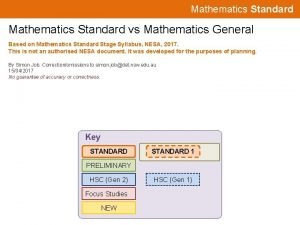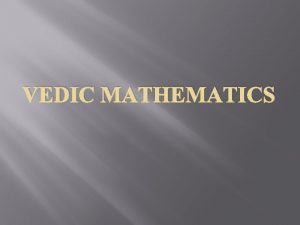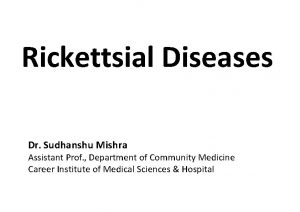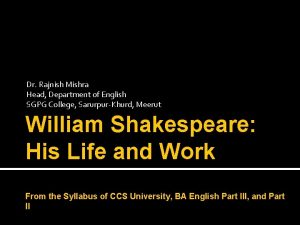Chapter 5 Nutan S Mishra Department of Mathematics




























- Slides: 28

Chapter 5 Nutan S. Mishra Department of Mathematics and Statistics University of South Alabama

Discrete Variables A random variable is a variable whose value is determined by the outcome of a random experiment. A random variable assigns a numerical value to an event in S Example: In tossing a coin S = {H, T} Define random variable as follows: X = 1 when H occurs X = 0 when T occurs. Here X is a discrete random variable.

Discrete Random Variable In some cases the outcomes of the experiment are themselves numerical values, in such a case we may not have to define a random variable separately. Example: rolling a die S ={1, 2, 3, 4, 5, 6}. All outcomes are numerical thus we do not have to define the random variable separately. Define X = # dots showed up X takes values 1, 2, 3, 4, 5, 6

Discrete Random variables Toss three coins and note the number of heads showed up. Let X = # heads occurred. Then x can take the values 0, 1, 2, 3 Number of vehicles owned by a family Number of dependents in a family Number of goals scored by a player

Continuous Random Variable • When outcomes of an experiment are numerical values in an interval then X is continuous • Example: Recording the GPA of students • X = GPA of a student • Then X [0, 4] and X can take any value in this interval. • X= highest temperature on a given day • X= Time taken by a runner to complete a race.

Probability Distribution Probability distribution of a discrete random variable is the set of all values of X and the set of corresponding probabilities P(X=x). Example: toss a single coin and observe the number of heads occurred. Define X = # heads Then X can take two values 0 or 1 X P(X=x) 0 . 5 1 . 5 These two columns together are called probability distribution of X

Probability distribution Toss three coins and define X = # heads then X=0, 1, 2, 3 S = {TTT, TTH, THT, HTT, HHT, HTH, THH, HHH} The probability distribution x is : X P(X=x ) 0 1/8 1 3/8 2 3/8 3 1/8

Properties of distribution P(X=x) is denoted by f(X=x) or just f(x) is called probability mass function. Two properties 1. f(x) 0 2. f(x) = 1 X P(X=x )=f(x) X P(X=x) = f(x) 0 . 5 0 1/8 1 . 5 1 3/8 2 3/8 3 1/8

Exercise 5. 8 x P(x) 0 . 10 2 . 35 1 . 05 3 . 28 2 . 45 4 . 20 3 . 40 5 . 14 ΣP(x) = 1. 00 x P(x) 7 -. 25 8 . 85 9 . 40 ΣP(x) = 1. 00 ΣP(x) =. 97

Exercise 5. 10 x 0 1 2 3 4 5 6 P(x) . 11 . 19 . 28 . 15 . 12 . 09 . 06 a. P(x=3) =. 15 b. P(x ≤ 2) = P(x=0)+P(x=1)+P(x=2) = c. P(x ≥ 4) = P(x=4)+P(x=5)+P(x=6) = d. P(1 ≤x ≤ 4) = P(x=1)+P(x=2)+P(x=3)+P(x=4) e. P(x<4) = 1 - P(x ≥ 4) f. P(x>2) = 1 - P(x ≤ 2) g. P(2 ≤x ≤ 5) = P(x=2)+P(x=3)+P(x=4)+p(x=50)

Exercise 5. 14 X = # TV sets owned by a family Size of the dataset is 2500 (This is a population) Use classical approach to find probability distribution of x. # TV sets owned (x) # families (f) P(x) 0 120 . 048 1 970 . 388 a. The two highlighted columns together form the probability distribution of X b. These probabilities are exact because this is a 3 410. 164 population data and we 4 270. 108 are using classical approach to compute sum 2500 1. 00 probabilties. C. P(x=1) =. 388, P(x≥ 3) = P(x=3)+P(x=4) =. 064+. 108 2 730 . 292 P(2 ≤ x ≤ 4) = P(x=2)+P(x=3)+P(x=4) =. 292+. 064+. 108 P(x<4) = 1 -P(x≥ 4) = 1 -P(x=4) = 1 -. 108

Mean of a discrete random variable x is the value that is expected to occur per repetition of the experiment. # TV sets owned (x) P(x) x. P(x) 0 . 048 0 1 . 388 2 . 292 . 584 3 . 164 . 492 4 . 108 . 432 sum 1. 00 Σx. P(x)=1. 896 Mean = 1. 896 TV sets Interpretation : If we repeat this experiment number of times then on the average a family owns 1. 896 TV sets.

Variance of discrete random variable # TV sets owned (x) P(x) x 2 P(x) 0 . 048 0 0 0 1 . 388 2 . 292 . 584 4 1. 168 3 . 164 . 492 9 1. 476 4 . 108 . 432 16 1. 728 sum 1. 00 Σx. P(x)=1. 896 σ2 = 4. 76 – (1. 896)2 = 1. 165184 σ = 1. 0794 4. 76

Exercise 5. 28 Machines sold/day (x) P(x) x 2 P(x) 4 . 08 0. 32 16 1. 28 5 . 11 0. 55 25 2. 75 6 . 14 0. 84 36 5. 04 7 . 19 1. 33 49 9. 31 8 . 20 1. 6 64 12. 8 9 . 16 1. 44 81 12. 96 10 . 12 1. 2 100 12 7. 28 Mean of x = 7. 28 56. 14 σ (Standard deviation) = 7. 4927 Interpretation: if experiment of collecting data on machines sales is collected for a large number of days then the on the average 7. 28 machines would be sold per day.

Counting revisited Useful links: http: //www. unc. edu/~knhighto/econ 70/lec 4. htm http: //pavlov. psyc. queensu. ca/~flanagan/20 2_1999/lecture 9. html

Factorials Example: three students with names A B C and three chairs red blue and yellow. Question: in how many ways students can be allocated to the chairs? A B C A C B B A C B C A B C B In general n distinct objects can be arranged in n places in n! (factorial n) ways n! = n*(n-1)*…*1 3! = 3*2*1 = 6 ways A

Permutations Example: four students A B C D and two chairs Question: How many ways a team of two students can occupy the chairs? A B A C A D B C B D C D B A C A D A C B D C # ways we can arrange n items in r places Is called permutation n. Pr = n*(n-1)*…(n-r+1) 4 P 2 = 4*3 = 12

Combinations Example: four students A B C D and two identical chairs. Question: In how many ways we can allocate students to the chairs? A B A C A D B C B D C D Here order does not matter (that is it does not matter which student occupies which chair because chairs are identical) # ways choosing r items out of n distinct items is 4 C 2 = 6 Table III on page C 7 lists the values of combinations

Bernoulli trials An experiment which has only two possible outcomes is a Bernoulli trial with probability of one outcome p and that of the other as 1 -p. Example: toss a coin : has only two outcomes H and T if P(H) =. 5 then P(T) = 1 -. 5 =. 5 If the coin is not fair and P(H) =. 7 then P(T) = 1 -. 7 =. 3

Bernoulli distribution More examples of Bernoulli trials: Inspecting a car at an assembly plant and declaring it as lemon or good. If P(L) =. 001 then P(G) =. 999 People entering into a football stadium. Classifying them into one of the genders. M or F if P(M) =. 62 then P(F) =. 38

Binomial Experiment A binomial experiment consists of n independent Bernoulli trials. That is repeating the Bernoulli experiment n times. Each repetition is independent of the other. Example: Toss three fair coins. n=3 Each coin is a Bernoulli trial. Outcome of one toss does not affect that of the others i. e. all tosses are independent. And p=. 5 for all the three tosses.

Binomial experiment Definition: 1. The experiment consists of n identical trials. 2. Each trial has only two possible outcomes 3. The probability of outcomes remain constant at each trial. 4. The trials are independent.

Binomial probability distribution In a Binomial experiment define a random variable x as X =# heads occurred in n tosses or X = # successes in n trials. Then x takes values 0, 1, 2 …, n Such an X is called Binomial random variable with n and p specified. If we repeat the binomial experiment a large number of times then we are interested probabilities of x assuming different values i. e in tossing n coins what is P(X=0) or P(X=1) and so on In other words we are interested in probability distribution of x.

Binomial distribution Consider a binomial experiment with n trials and p as probability of success in a single trial then X = # successes in n independent trials is a binomial variable and its probability distribution is called Binomial distribution with parameters n and p P(x=k) = n. Ck pk (1 -p)n-k for x = 0, 1, …n Alternatively replace 1 -p =q P(x=k) = n. Ck pk qn-k for x = 0, 1, …n

Exercise 5. 51 a. b. c. Rolling a die many times and observing # spots is not a binomial experiment because there are more than two possible outcomes of a roll Rolling a die many times and observing whether the number is even or odd is a binomial experiment because at each roll there are only two possible outcomes: even or odd. Besides all the rolls are independent. Yes this a binomial experiment because we are selecting a few people, each person has only two possible answers: in favor or not in favor. The probability of an individual being in favor is known i. e. . 54 and all persons answers are independent.

Exercise 5. 53 a. x= binomial vairate with n=8 and p=. 7 P(x=5) = 8 C 5 *p 5 (1 -p)8 -5 = 8 C 5 *p 5 (1 -p)3 = 8 C 5 *(. 7)5 (. 3)3 =. 2441 (from table iv) b. Given n=4, p=. 40 P(x=3) = 4 C 3 *p 3 (1 -p)4 -5 = 4 C 3 *(. 4)3 (. 6) =

Mean and Variance of binomial Let x be a binomial variable with parameters n and p. then mean of x µ = Σx. n. Ck pk (1 -p)n-k = np µ = np Variance σ2 = npq

Exercise 5. 58 Question asked: Do you eat home cooked food three or more times a week? Yes: 85% No: 15% P(Y) = p =. 85 P(N) = 1 -p =q =. 15 a. n=12 (a random sample of 12 Americans) is selected X = # Americans from the sample of 12 who say Yes Then X has binomial distribution with parameters n=12 and p=. 85 X may take values between 0 to 12 That is there may be o Americans who say yes or may be 2. . 0 r at the most 12 will say yes. b. What is the probability that 10 out of 12 Americans say yes to the posed question? P(X=10) = 12 C 10 *p 10(1 -p)12 -10 = 12 C 10 *p 10(1 -p)2
 Nutan patel
Nutan patel David von flittner
David von flittner Dr anoop mishra herbalife
Dr anoop mishra herbalife Nina mishra
Nina mishra Smita mishra panda
Smita mishra panda Imnci guidelines for diarrhoea
Imnci guidelines for diarrhoea Bud mishra
Bud mishra Scramv
Scramv Kalanand mishra
Kalanand mishra Lasert tag
Lasert tag Kirti mishra
Kirti mishra Dr arvind mishra
Dr arvind mishra Dr padma mishra bhopal
Dr padma mishra bhopal Dr manisha mishra
Dr manisha mishra Science dadeschools
Science dadeschools Math building purdue
Math building purdue Department of mathematics
Department of mathematics Nit calicut mathematics department
Nit calicut mathematics department The value of 52003 mod 7 is?
The value of 52003 mod 7 is? P double implies q
P double implies q Business math chapter 2
Business math chapter 2 Discrete mathematics chapter 1
Discrete mathematics chapter 1 Chapter 3 what mathematics is about summary
Chapter 3 what mathematics is about summary Business mathematics ppt
Business mathematics ppt Discrete mathematics chapter 1
Discrete mathematics chapter 1 Mathematics timetable
Mathematics timetable Workkeys applied mathematics level 4 answers
Workkeys applied mathematics level 4 answers Wisconsin math council
Wisconsin math council Where mathematics comes from
Where mathematics comes from
